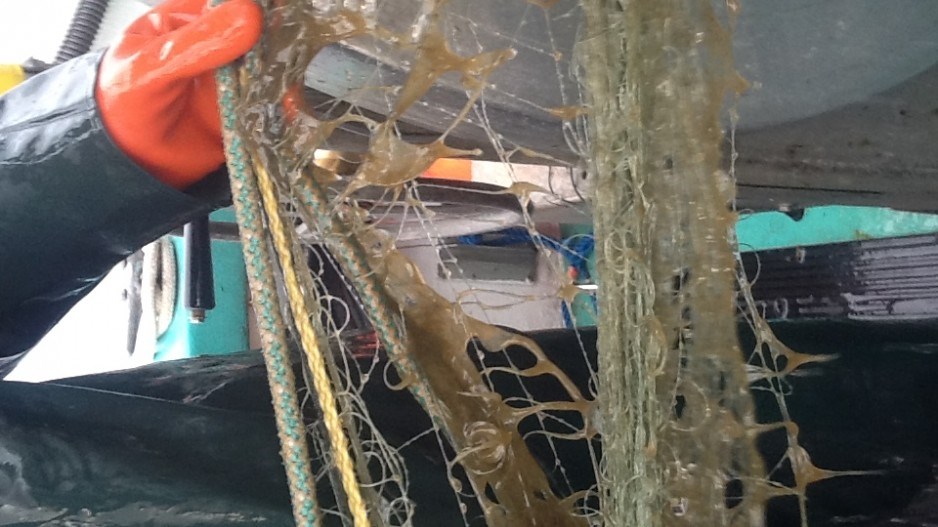When north coast fishermen set their nets on June 9 in anticipation of a good fishing season, they got more than they bargained for – and less.
Along with Nass River sockeye, their nets pulled up thick blankets of slime.
It was originally thought to be marine algae, but the Department of Fisheries and Oceans (DFO) has determined the slime to be a “goo” of phytoplankton. It’s believed to have been caused by unusually warm ocean temperatures in the northern Pacific Ocean.
The slime fouled fishing nets so badly that some fishermen managed to get in only one set before the opening ended, and in a subsequent opening, others had already called it quits, said United Fishermen and Allied Workers Union spokeswoman Joy Thorkelson.
She added that, with 775,000 sockeye predicted to return to the Nass, the seine and gillnet fleets expected an allocation of about 200,000 fish. But Thorkelson estimated that this year’s take probably won’t be more than 60,000.
To make matters worse, as of mid-July, Skeena River sockeye – with a predicted run size of 3.5 million – were a no-show.
Based on estimated returns, commercial fishermen have been hoping for an allotment of 900,000 fish. But as of mid-July, only 130,000 had returned – less than half of the escapement target set by DFO.
Pacific salmon are being hit this year by a double whammy of heat in both the ocean and in rivers.

“As far as sockeye salmon are concerned, in terms of the challenge in the freshwater migration, this is about as severe as we could ever anticipate,” said University of BC biologist Tony Farrell.
Since the fall of 2013, scientists have been tracking a large expanse of unusually warm water – dubbed “the blob” – in the northern Pacific Ocean that is 3 C warmer than average (see image right, National Oceanic and Atmospheric Administration).
“By the time January 2014 arrived, we had record high temperatures,” said DFO fisheries scientist Ian Perry.
The warm water is believed to be changing the food web and fish migration patterns. It has also brought predators, such as mackerel and tuna, north from more southern waters.
Those conditions will make it especially hard on juvenile salmon that moved into the ocean in the spring of 2015, which means the 2019 returns could be affected.
The mature salmon that have managed to survive whatever is going on in the ocean to make it to the mouths of their native rivers in B.C. this year face the added challenge of critically low river levels and high temperatures.

Initial numbers show a much lower than expected sockeye run for both the Nass and Skeena rivers in northern B.C.
The problem is most pronounced on Vancouver Island, which had virtually no snowpack this year, leaving rivers dangerously low. Fishing bans have been implemented on several Vancouver Island rivers to protect trout, steelhead and salmon stocks. Closures in other parts of B.C. are also being implemented.
Fraser River sockeye are also in for a hostile homecoming in August.
Sockeye and coho are extremely sensitive to temperature and have been know to stall at the mouth of their native rivers when temperatures are too high.
Fraser River water flow is at its lowest in 25 years, Farrell said, and temperatures are reaching levels that can be lethal, which could mean high mortality rates for this year’s returning adult salmon.
Fisheries managers therefore will likely have to increase escapement targets this year for Fraser River sockeye.
The 2015 return is predicted to be about 6.8 million – approximately 1.5 million above the average. But if escapement targets are raised, that would cut into this year’s take for seine and gillnet fleets.
Thorkelson said there’s little question the conditions threatening Pacific salmon are linked to climate change. She said governments need to start implementing policies to deal with its impacts on the commercial fishing sector.

Fisherman expecting a good fishing season on the Nass and Skeena rivers had their nets fouled by a strange goo later discovered to be phytoplankton reacting with warmer than usual water | Submitted
Thorkelson said it’s time the commercial sector had some kind of insurance, like the crop insurance that Prairie farmers have when crops are wiped out by hail or drought.
She added that DFO needs to consider management tools other than quota systems. The purse seine fleet moved to a quota system a few years ago, and the gillnet and seine fleets have been under increasing pressure to do the same.
A quota system avoids the shotgun approach to fishing under which commercial fishermen scoop up as much fish as they can during brief openings.
A quota system caps how much licence-holders can catch, so they can make their own decisions when to go fishing and stop when they reach their quota. It’s also better system for fish processors and packers because the fish supply gets smoothed out.
But independent fishermen hate the idea because unless quotas are tied to specific boats and boat owners, they say it will result in the privatization of a public resource, with all licences concentrated in the hands of just a few large companies, like Canadian Fishing Co. (Canfisco).
@nbennett_biv




